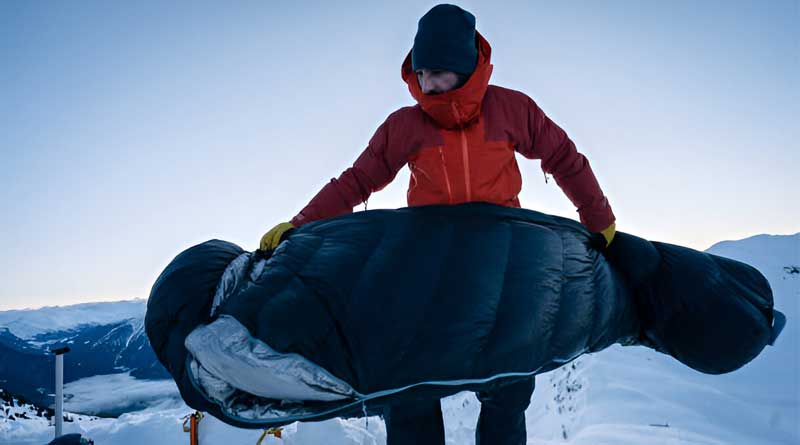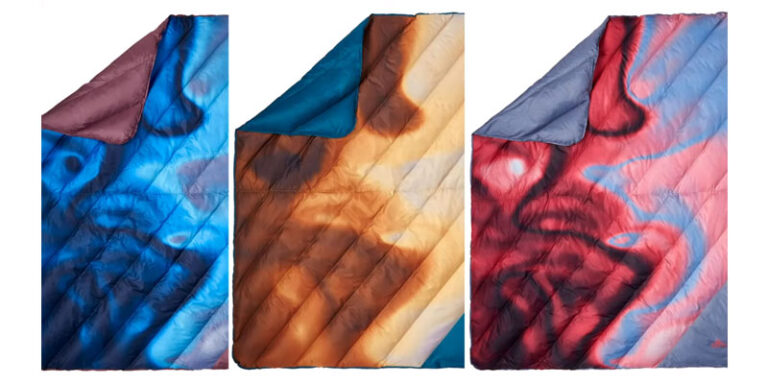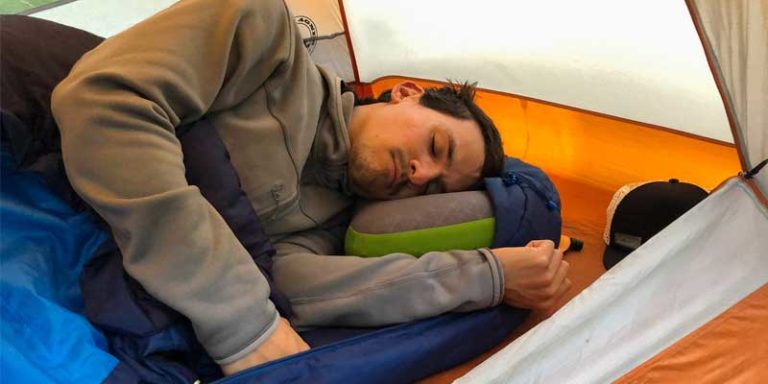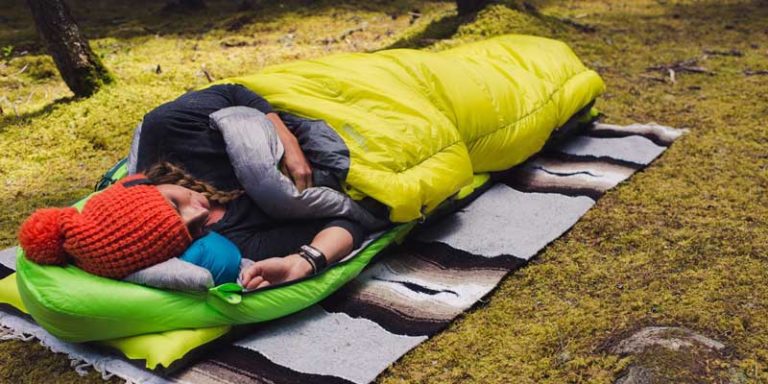Finding the right sleeping bag in the can be tricky. Cold nights demand a bag that keeps you warm. Whether you camp in snow or frosty hills, warmth matters most. The right sleeping bag can make cold trips comfortable. Some bags work well in damp British weather. Others are light but still very warm. You’ll also want one that packs down small. In this guide, we’ll show the best winter sleeping bags available in the UK. We’ve looked at warmth, weight, price, and comfort. Whether you’re wild camping or hiking, there’s a good option here. Stay warm, sleep well, and enjoy your winter adventures with the right bag.
1. Trail Alpine 400

- Temperature Rating: Comfort at 0°C, extreme limit -10°C
- Insulation: Double-layered 2 x 200gsm hollowfibre with offset quilting
- Shell & Lining: Water-resistant 190T polyester shell, soft polycotton liner
- Weight & Pack Size: 2kg, packs down to approx. 38cm x 29cm x 29cm
The Trail Alpine 400 is a warm and reliable four-season sleeping bag. It’s designed for winter camping and cold nights all year. With a comfort rating of 0°C and a lower limit of -10°C, it keeps you cosy in harsh weather. The drawcord hood helps trap heat and keeps your head snug. You can also use the hood to keep your pillow in place. The sleeping bag feels soft inside and has a durable shell to resist damp conditions. Its double-layer hollowfibre insulation offers great warmth without making the bag too heavy.
One of the standout features is the two-way zip. On warmer nights, you can open it slightly or fully for airflow. When it’s cold, zip it up tight and secure it with Velcro to stop heat escaping. It also comes with a compression bag for easy packing. Just stuff the sleeping bag in and tighten the straps. Although it’s bulky, that extra thickness means more warmth. I used this bag during a chilly August trip and stayed toasty warm. Even when it got too warm, I could unzip it and use it like a blanket. The quality feels excellent, and the purple colour looks great. Delivery was fast and the price was very fair.
Pros
- Very warm and well insulated
- Great for year-round use
- Comfortable inner lining
- Excellent value for money
Cons
- A bit bulky when packed
- Too warm for hot summer nights
2. BISINNA Sleeping Bag

- Temperature Rating: Comfort at 10°C, limit at 5°C, extreme at 0°C
- Insulation: 400GSM hollow cotton filling
- Shell Material: Waterproof 210T polyester outer, soft and skin-friendly
- Weight & Portability: Includes compression sack with straps, machine washable
The BISINNA Sleeping Bag is made for comfort and warmth. It’s filled with 400GSM hollow cotton that keeps you warm on cool nights. The comfort range starts at 10°C, which makes it great for spring and early autumn trips. The outer shell is waterproof and the inner lining feels soft and cosy. It also packs away easily using the included compression sack, though it’s a bit larger than other bags. That extra size gives you more warmth and space, making it worth it. I found it much thicker than my old bag and way more comfortable.
The sleeping bag has clever features. A bottom zip lets you cool your feet or walk around in it. You can even zip two bags together to make a double. There’s a small hood with a drawstring to keep your head warm. I liked most of it, but the pillow was too small and didn’t stay in place. The valuables pocket also felt awkward. I tried using it for my phone, but it ended up under my neck. Still, those are minor issues. The zip sometimes caught on the fabric but was easy to fix. Overall, it’s a great bag that kept me warm and rested. I do love using it.
Pros
- Very warm and soft
- Waterproof and durable
- Bottom zip is very useful
- Easy to carry and clean
Cons
- Pillow is too small
- Pocket placement is awkward
- Zip can get caught sometimes
3. MalloMe Sleeping Bag

- Temperature Rating: Comfort from 10°C to 25°C
- Material: Waterproof hex-tech shell, double-layered with S-stitching
- Insulation: 3D synthetic fiber fill for warmth
- Weight & Portability: Weighs around 3lbs, comes with compression sack
The MalloMe Sleeping Bag is a solid choice for camping or home use. It’s light, easy to pack, and warm for most seasons. The comfort range starts at 10°C, so it’s great for spring, summer, and mild autumn nights. The shell is waterproof and easy to clean, which is ideal for outdoor use. Inside, the material feels soft and warm. I used it in March and stayed comfortable through the night. It rolls out quickly and fits adults up to 6ft tall. I’m 5’7” and had plenty of space to move around.
This sleeping bag is also great for guests at home. I don’t usually camp, but it worked well for sleepovers. It comes with a small pillow built in, though I’d recommend using a better one. The zip opens and closes easily, and the bag stays in place with Velcro straps. The drawstring near the headrest keeps things snug and warm. Packing it away is simple with the included compression bag. For the price, the quality is excellent. It’s lightweight, warm, and takes up little storage space. I highly recommend it for casual campers or guest use.
Pros
- Lightweight and compact
- Soft, warm, and spacious
- Easy to pack and clean
- Great value for money
Cons
- Not warm enough for winter
- Built-in pillow is too small
- Best used with mild temperatures
4. JEAOUIA Sleeping Bag

- Size: 31.5 x 86.6 inches; fits people up to 5ft 11in
- Temperature Range: Comfortable from 10°C to 20°C; limit range from 5°C to 25°C
- Materials: 190T waterproof nylon shell, polyester pongee lining, hollow cotton filling
- Design Features: Drawstring hood and bottom zip for airflow control
The JEAOUIA Sleeping Bag is a great option for mild weather camping. It works well in spring, summer, and autumn. The hollow cotton filling is soft and warm, and the lining feels nice against the skin. It fits most people under 6 feet tall with plenty of room to stretch out. I found it lightweight and easy to carry. The zippers are smooth and don’t snag, which makes it quick to get in and out. I liked that you can open just the bottom to cool your feet when it’s too warm.
This bag also opens fully into a blanket, which is a great feature. I used two together—one as a base, one as a cover. They zip into one big sleeping bag, perfect for two people. The waterproof shell kept me dry even with damp ground. It also wipes clean easily, which is handy after muddy nights. The hood with drawstring helped trap warmth around my head. For the price, it’s excellent value. It’s not for freezing winter nights, but for most trips, it’s ideal. It kept me warm, packed down small, and didn’t cost much. I’d happily recommend it to campers and families alike.
Pros
- Lightweight and easy to carry
- Converts to a blanket or double bag
- Soft, warm, and comfortable
- Very affordable
Cons
- Not suitable for winter
- Pillow not included
- Might be short for taller users
5. Trail Envelope With Snug Hood

- Temperature Range: Comfort at 5°C, extreme rating of -5°C, max 15°C
- Insulation: 250g/m² hollow-fibre fill with water-resistant polyester shell
- Size: 190cm x 75cm (220cm with hood); packed size: 36cm x 22cm x 22cm
- Weight: 1.3kg; includes drawstring storage bag with straps and hanging loops
The Trail Envelope sleeping bag is warm, roomy, and perfect for cold nights. I used it in early autumn and felt very cosy. The snug hood can be tightened to trap heat around your head. The insulation feels thick and soft, making it very comfortable. I liked that the shell is water-resistant—it kept my sleeping bag dry even after spilling coffee. The zippers feel solid, and the Velcro tabs are strong. It’s easy to get in and out with the full-length zip.
Packing it up is simple. The drawstring bag has straps to keep it compact, though it’s still quite bulky. If you’re a backpacker, it might be too large. But for car camping or base camps, it’s excellent. There’s loads of room to stretch out and move around. I slept really well in it, and it kept me warm all night. The machine-washable design is another plus. It’s great value if you want a big, warm bag that’s built to last.
Pros
- Very warm and spacious
- Water-resistant and machine washable
- Snug hood traps heat
- Strong zippers and Velcro
Cons
- Very bulky when packed
- Not ideal for backpacking
- No inner pocket for valuables
6. COVACURE Sleeping Bag

- Size: 220 x 80 cm (86.6 x 31.5 inches); fits adults up to 6 ft
- Weight: 1.5 kg; includes Oxford compression sack
- Materials: 210T polyester shell with 100% hollow fiber filling
- Features: Two-way zipper, internal stash pocket, drawcord hood
The COVACURE sleeping bag is warm, roomy, and ideal for car camping or festivals. I used it on a 10-day trip in Scotland. It handled 6°C nights easily and kept me cosy. The hollow fibre filling spreads evenly and stays warm, even when damp. The rectangular shape gives plenty of space to move around. It’s got a handy drawcord hood and a zip baffle to block cold air. I liked the little stash pocket near the head for my phone and keys.
Packing is simple with the compression sack, though it’s not the lightest bag. At 1.5 kg, it’s okay for short backpacking trips but better for car camping. The double zipper works smoothly and lets you open the bottom to cool your feet. It also opens fully to work as a picnic blanket. I didn’t expect much for the price, but it’s well-made and durable. This is now my go-to bag when weight isn’t an issue.
Pros
- Very warm and good in cold weather
- Roomy and comfortable design
- Strong materials with smart features
- Great value for the price
Cons
- A bit heavy for long hikes
- Not compact for ultralight camping
- Hood could be slightly deeper
7. SAIL 3-4 Season Bag

- Filling: 250GSM insulation with polyester outer shell
- Temperature Rating: Comfortable between 10°C to 0°C; down to -5°C extreme
- Weight: 1.3kg; lightweight and easy to carry
- Size: 220cm x 75cm; fits most adults comfortably
The SAIL sleeping bag is warm, comfy, and perfect for cold nights. It works great in spring, summer, or autumn. I didn’t use it myself but bought it for someone who sleeps outdoors. He said it made a huge difference. He now feels warm and snug even when temperatures drop low. The thick filling and water-resistant fabric help keep out cold and damp. It’s not bulky either, so carrying it is simple.
The bag’s build quality is solid for the price. It’s light enough for hikes and still very cosy. The person using it said it’s the best one he’s had. It made him feel safer and warmer through the night. This bag gives good insulation and has a nice soft feel. It’s long enough for most adults and zips up easily. For anyone who camps or sleeps outside, it’s a great option. It offers comfort without costing too much.
Pros
- Warm and suitable for low temperatures
- Lightweight and easy to pack
- Water-resistant and durable materials
- Good value and comes with a warranty
Cons
- May be too warm for hot summer nights
- Not compact enough for ultralight backpacking
- No inner pocket for storage
How to Choose Winter Sleeping Bags in the UK
Choosing the right sleeping bag is essential for comfort and safety during cold nights. Whether you’re planning a frosty wild camp in the Lake District, a winter hike in the Scottish Highlands, or just need reliable warmth for an unheated campervan, the right bag makes all the difference. With many options on the market, this guide will help you understand what to look for in a winter sleeping bag suited to UK conditions.
1. Understand Temperature Ratings
The first and most important step is checking the temperature rating of a sleeping bag. Sleeping bags in the UK usually follow the EN 13537 (or newer ISO 23537) standard, which gives three useful numbers:
- Comfort rating – the lowest temperature at which a cold sleeper will feel comfortable.
- Limit rating – the lowest temperature for a warm sleeper to stay comfortable.
- Extreme rating – the temperature at which you may survive, but not comfortably.
For UK winter use, look for a comfort rating of at least -5°C to 0°C. The UK rarely hits extreme lows, but wind chill and wet conditions can still be dangerous, especially when wild camping. A bag with an extreme rating below -10°C is advisable for higher altitude or northern winter trips.
2. Choose the Right Insulation: Down vs Synthetic
There are two main types of insulation in sleeping bags: down and synthetic. Each has pros and cons:
Down Sleeping Bags
- Pros: Excellent warmth-to-weight ratio, compressible, long-lasting.
- Cons: Loses warmth when wet, more expensive, may require extra care.
Down is ideal for dry, cold conditions or for people who need a lightweight bag for long hikes. Look for hydrophobic down (treated to resist moisture) if camping in damp UK conditions.
Synthetic Sleeping Bags
- Pros: Warms even when wet, affordable, quick-drying.
- Cons: Heavier and bulkier than down.
Synthetic is best for wet, muddy conditions, and is a safer choice for beginners, car campers, and those on a budget.
3. Look at Fill Power and Fill Weight
If you choose a down bag, check the fill power (usually 500–900). A higher fill power means more warmth for less weight. For winter, aim for 700 fill power or above.
Also consider the fill weight, which tells you how much down is used. Even a high fill power bag won’t be warm enough if it lacks enough down.
For synthetic bags, look at the GSM (grams per square metre). In the UK winter, bags with 300–400 GSM offer solid warmth.
4. Bag Shape and Size Matter
Sleeping bags come in different shapes:
- Mummy bags: Tapered for better heat retention and lighter weight.
- Rectangular bags: Roomier but less thermally efficient.
- Semi-rectangular: A good balance between comfort and warmth.
In winter, mummy bags are the best for warmth, as they hug the body and reduce dead space that your body has to warm.
Make sure the bag suits your height and shoulder width. A bag that’s too big lets in cold air; too small and you’ll feel cramped.
5. Hood, Draft Collar, and Zips
A good winter bag should have a snug, adjustable hood to retain heat. Look for:
- Draft collars or baffles around the neck and zip area to stop warm air escaping.
- Two-way zippers for ventilation and easy access.
- Anti-snag zippers and zip guards to avoid cold spots and frustration in the dark.
6. Weight and Packability
If you’re backpacking or hiking in winter, weight is a key factor. A good sleeping bag should balance warmth with portability. 1.2–2.5kg is typical for a winter-rated bag, depending on the materials used.
Down bags pack smaller and weigh less, making them a better option for those with limited space. Synthetic bags are bulkier but may come with compression sacks to reduce their size.
7. Water Resistance
In the UK, wet gear is a real risk, even in tents. Look for:
- A DWR (durable water repellent) coating on the outer shell.
- Water-resistant compression sacks.
- Down bags with a hydrophobic treatment to resist moisture.
If you’re winter camping in snow or damp woodland, these features can make a huge difference in comfort and safety.
8. Bag Lining and Interior Features
Soft, moisture-wicking inner linings are more comfortable and help prevent clamminess. Some bags come with handy inner pockets to store your phone or headtorch close to your body to keep them warm.
If you get cold feet, some bags include extra insulation in the footbox.
9. Budget: How Much Should You Spend?
Expect to pay:
- £50–£100 for a good entry-level synthetic winter bag.
- £100–£250 for mid-range bags with better insulation and features.
- £250+ for premium down sleeping bags from brands like Rab, Mountain Equipment, or Therm-a-Rest.
If you camp often in winter, it’s worth investing in a high-quality bag. For occasional or car camping trips, a cheaper but bulky synthetic option might be enough.
10. Top UK Brands and Recommendations
Some respected brands for UK winter conditions include:
- Rab – Known for high-quality down bags, made for UK mountaineering.
- Mountain Equipment – Excellent cold-weather performance and British-designed.
- Snugpak – Affordable, rugged synthetic bags popular with military and bushcraft users.
- Vango – Good balance of cost and comfort for general camping.
- Alpkit – Great value for down sleeping bags, especially for lightweight needs.
Conclusion
Choosing a sleeping bag in the UK means understanding the balance between warmth, weight, and durability. Always check the comfort temperature, choose insulation based on your needs, and make sure it fits your body well. Whether you’re hiking in the Highlands or camping in Cornwall, the right sleeping bag will help you sleep soundly—no matter how wild the weather gets.



